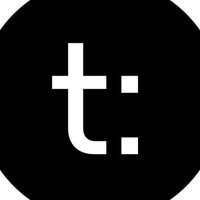Best For | WordPress users wanting advanced, customizable course creation with full control. | Beginners seeking a simple, all-in-one platform for online courses. |
Price | Starts from $199/year | Starts from $29/month (Billed annually) |
Features | Drag-and-drop builder | Easy course creation |
Pros | Highly customizable options | Super simple setup |
Cons | Needs technical skills | Limited design control |
When it comes to creating and selling online courses, two of the most popular platforms are LearnDash and Teachable.
Both have their strengths and cater to different needs, making it tough to choose between them.
If you’re trying to decide which platform suits your business, you’ve come to the right place.
In this blog, I’ll compare LearnDash and Teachable based on features, pricing, ease of use, and more to help you make an informed decision.
Bottom Line Upfront: Teachable is a better option when compared to LearnDash in terms of its teaching style, course content, course creation and much more. Most of the users trusted Teachable and they are working and learning with Teachable ever since and I am one of them. Start creating course or learning with Teachable today.
LearnDash Vs Teachable: Overview
LearnDash
LearnDash is a Learning Management System (LMS) plugin for WordPress. It’s perfect for course creators who want full control over their content, branding, and monetization options.
As a WordPress plugin, LearnDash integrates seamlessly with your WordPress site, giving you flexibility when it comes to design and customization.
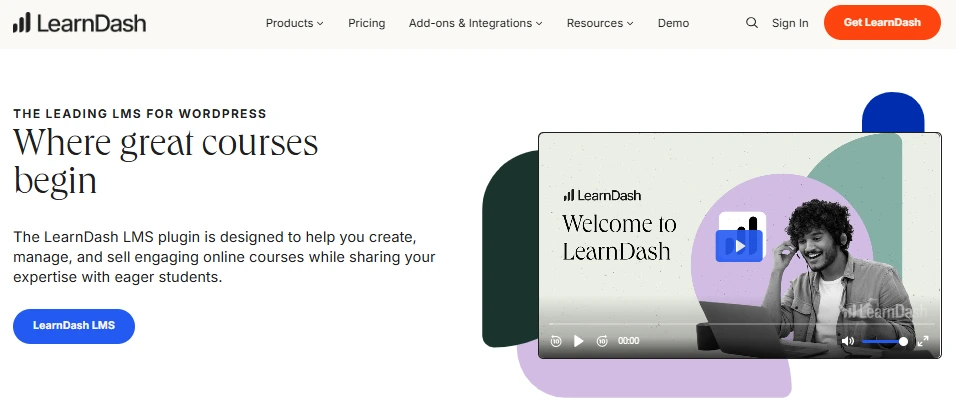
I’ve used LearnDash for several courses, and one of the things I love is the drag-and-drop course builder. It’s easy to organize your content without any coding knowledge.
LearnDash also has some powerful features like gamification, advanced reporting, and drip-feed content, which makes it ideal for anyone looking to build a more engaging and structured learning experience.
Key Features of LearnDash:
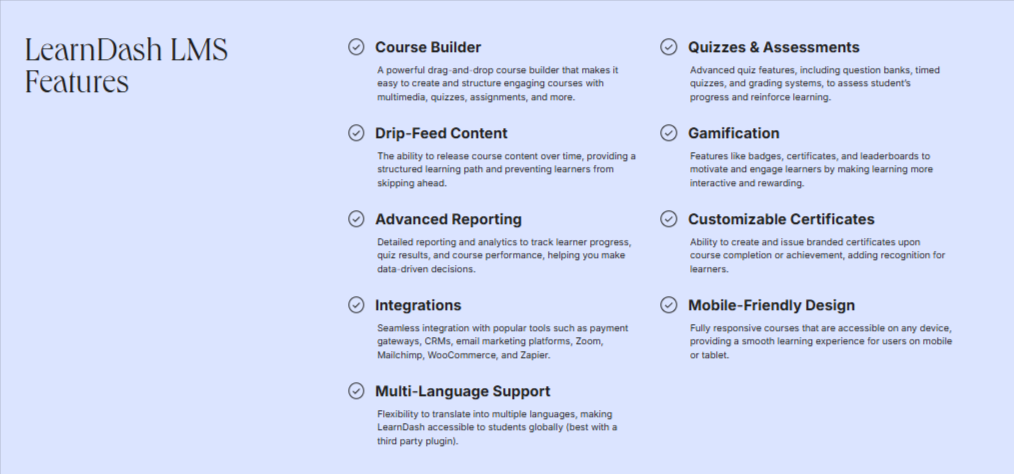
1. Course Builder:
LearnDash offers a drag-and-drop course builder that makes creating and organizing courses easy. You can integrate multimedia, quizzes, assignments, and more to create engaging and interactive learning experiences.
2. Quizzes & Assessments:
Advanced quiz features, such as question banks, timed quizzes, and grading systems, allow you to assess students’ progress and reinforce their learning. These tools make it easy to create structured assessments for any course.
3. Drip-Feed Content:
LearnDash offers drip-feed content, allowing you to release course material over time. This helps create a structured learning path for students and ensures they can’t skip ahead to later lessons without completing the current ones.
4. Gamification:
To keep students engaged, LearnDash has gamification features like badges, leaderboards, and certificates that reward students for their achievements and motivate them to stay committed to their learning.
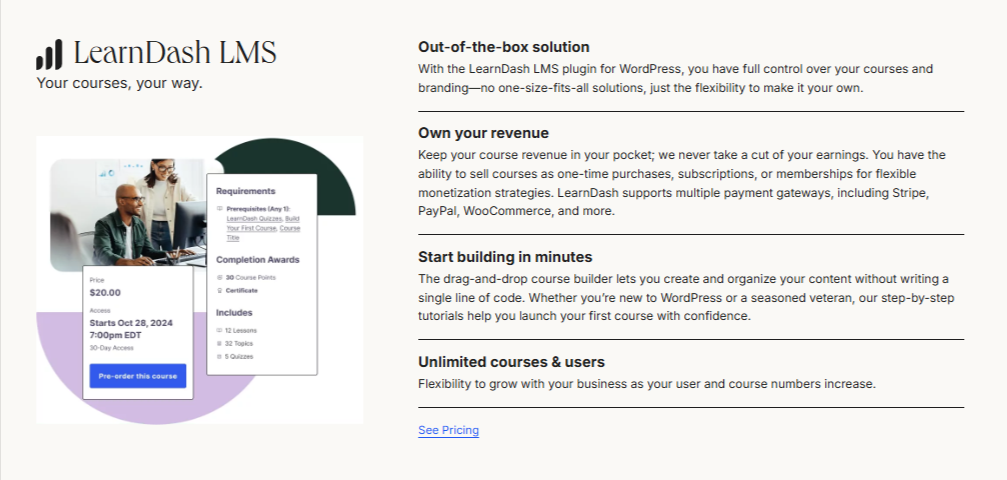
5. Advanced Reporting:
LearnDash provides detailed reports on student progress, quiz results, and overall course performance. This feature helps you make data-driven decisions to improve your course content and student engagement.
6. Customizable Certificates:
You can create and issue branded certificates to students upon course completion or achievement, adding an element of recognition and credibility to their success.
7. Integrations:
LearnDash integrates with popular tools like payment gateways, CRMs, email marketing platforms, Zoom, Mailchimp, WooCommerce, and Zapier, allowing you to automate tasks and streamline your workflows.
8. Mobile-Friendly Design:
All LearnDash courses are fully responsive, meaning they work seamlessly on any device. This provides a smooth and consistent experience for students accessing content on mobile or tablet.
9. Multi-Language Support:
LearnDash allows you to translate your courses into multiple languages, making it accessible to a global audience. (This is best with a third-party plugin.)
Teachable
Teachable, on the other hand, is a hosted platform that allows you to create, market, and sell online courses.
Teachable is super intuitive and beginner-friendly, which is why it’s great for course creators who prefer an all-in-one platform without the technicalities of managing a WordPress site.

With Teachable, I’ve found that creating and launching a course is a breeze. The platform provides powerful course creation tools, student management features, and marketing tools, all without requiring any coding skills.
One of the things I like the most is the ability to sell courses, coaching, and digital downloads all from one place.
Key Features of Teachable:
1. Course Creation:

Teachable provides a drag-and-drop course builder that makes it simple to create and organize lessons, videos, quizzes, and assignments. It’s designed to be intuitive and quick to use, with no coding required.
2. Student Management:

Teachable offers tools to manage students, track their progress, and provide support. It includes features like student enrollment, progress tracking, and course completion certificates.
3. Marketing Tools:

Teachable comes with built-in sales pages, coupon codes, affiliate marketing tools, and email marketing features, which help you promote your courses and grow your business. It’s a great option for creators who want all their tools in one platform.
4. Payment Processing:
Teachable handles payment processing via PayPal and Stripe, so you can accept payments directly on your site. There are no transaction fees on the paid plans, making it easier to keep more of your earnings.
5. Custom Branding:
While Teachable offers some customization, it doesn’t give as much freedom as LearnDash when it comes to design. However, you can customize your course site’s colors, logos, and branding to align with your personal or business brand.
6. Mobile App:
Teachable offers a mobile app for students to access courses on the go, providing flexibility for learners to study anywhere, anytime.
7. Student Communities:
Teachable lets you create private communities for your students to interact with each other. This can be a great way to foster a sense of connection and community among learners.
8. Analytics:
Teachable includes basic reporting and analytics features to help track student progress, sales, and other key metrics.
Feature Comparison: LearnDash vs. Teachable
| Feature | LearnDash | Teachable |
|---|---|---|
| Course Builder | Powerful drag-and-drop builder with multimedia, quizzes, and assignments | Simple drag-and-drop builder for video, quizzes, and lessons |
| Monetization | One-time purchases, subscriptions, memberships | One-time purchases, subscriptions, coaching |
| Gamification | Badges, certificates, and leaderboards | Limited gamification features |
| Student Management | Advanced student tracking and reporting | Basic student management and tracking |
| Integrations | WooCommerce, Stripe, PayPal, Mailchimp, and more | PayPal, Stripe, email marketing, and affiliate programs |
| Mobile-Friendly Design | Fully responsive for all devices | Mobile app available for students |
| Customization | Full customization with WordPress flexibility | Limited customization options |
| Language Support | Multi-language support (via third-party plugins) | No built-in multi-language support |
| Ease of Use | Requires WordPress knowledge | Very easy to use for beginners |
Pricing Comparison: LearnDash Vs Teachable
LearnDash:

- 1 Site: $199/year for 1 site, includes all basic features like course creation and reporting.
- 10 Sites: $399/year for 10 sites, adds group management and extra integrations.
- Unlimited: $799/year for unlimited sites, includes advanced features like course bundles and private lessons.
Teachable:
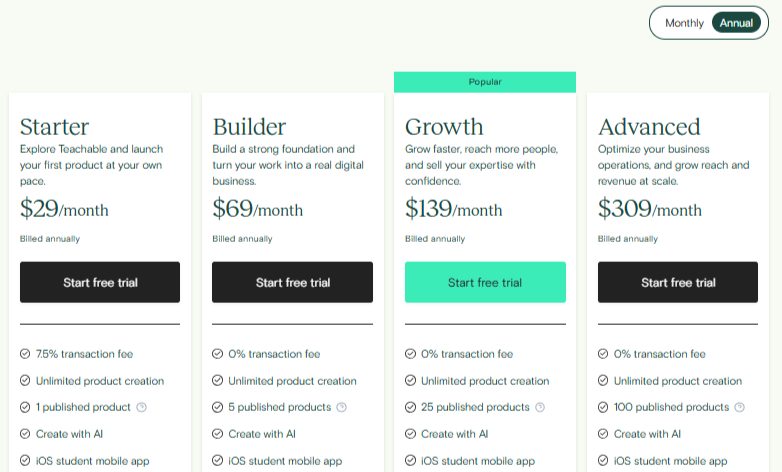
- Starter Plan: $29/month (billed annually), includes unlimited product creation and 1 published product with a 7.5% transaction fee. This plan is great for beginners just starting out.
- Builder Plan: $69/month (billed annually), includes unlimited products, 5 published products, 0% transaction fees, and affiliate programs.
- Growth Plan: $139/month (billed annually), includes 25 published products, 0% transaction fees, and a white label website.
- Advanced Plan: $309/month (billed annually), includes 100 published products, unlimited integrations, white label website, and custom admin permissions.
- Custom Plan: Contact sales for custom pricing, includes features tailored to your business, with bulk student imports and priority support.
Pros & Cons: LearnDash Vs Teachable
LearnDash
Pros
- Highly customizable for unique courses
- One-time purchase saves money long-term
- Strong community for troubleshooting help
- Seamless integration with WordPress sites
- Detailed analytics to track progress
- Supports advanced learning features
Cons
- Requires technical know-how to start
- Setup can feel overwhelming initially
Teachable
Pros
- Super simple setup for beginners
- Great customer support always available
- Handles payments and taxes smoothly
- Professional design with zero effort
- Affordable plans for small budgets
- Quick launch for fast results
Cons
- Limited control over design elements
- Monthly fees increase with growth
FAQs On LearnDash Vs Teachable:
1. Which platform is better for a WordPress user?
If you’re familiar with WordPress, LearnDash is a better option because it integrates seamlessly into the WordPress ecosystem.
2. Can I use Teachable without a website?
Yes, Teachable is a hosted platform, meaning you can create your course site directly on Teachable without needing a separate website.
3. Does LearnDash offer student certificates?
Yes, LearnDash allows you to create and issue customizable certificates upon course completion.
4. Can I migrate my courses from Teachable to LearnDash or vice versa?
Yes, you can migrate your courses between platforms, but it may require some manual effort or third-party tools, especially when moving from Teachable (a hosted solution) to LearnDash (a WordPress plugin) or vice versa.
5. Does LearnDash offer a free plan?
No, LearnDash does not offer a free plan. It offers paid plans starting at $199/year for the basic plan, but you can try it out with a demo or purchase a yearly license.
Quick Links:
Conclusion: Teachable Vs Learndash 2025
Both LearnDash and Teachable offer robust tools for course creation, but the best choice depends on your needs.
- LearnDash is ideal if you want complete control over your course design, monetization, and website. It’s best for those who are comfortable with WordPress and want advanced features like gamification and custom reporting.
- Teachable is the go-to choice for users who want a simplified, hosted solution that takes care of all the technical aspects, with powerful sales tools and affiliate marketing features.
No matter which platform you choose, both Teachable and LearnDash offer free trials, so you can explore their features and find the best fit for your online course business.


